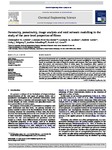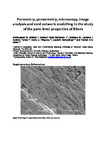Porometry, porosimetry, image analysis and void network modelling in the study of the pore-level properties of filters
| dc.contributor.author | Gribble, CM | |
| dc.contributor.author | Matthews, Peter | |
| dc.contributor.author | Laudone, Giuliano Maurizio | |
| dc.contributor.author | Turner, Andrew | |
| dc.contributor.author | Ridgway, CJ | |
| dc.contributor.author | Schoelkopf, J | |
| dc.contributor.author | Gane, PAC | |
| dc.date.accessioned | 2014-04-15T08:56:28Z | |
| dc.date.accessioned | 2014-04-15T08:59:21Z | |
| dc.date.available | 2014-04-15T08:56:28Z | |
| dc.date.available | 2014-04-15T08:59:21Z | |
| dc.date.issued | 2011-08 | |
| dc.identifier.issn | 0009-2509 | |
| dc.identifier.uri | http://hdl.handle.net/10026.1/2986 | |
| dc.description | File replaced (incorrect version) on 29/7/2022 by KT (LDS). | |
| dc.description.abstract |
We present fundamental and quantitative comparisons between the techniques of porometry (or flow permporometry), porosimetry, image analysis and void network modelling for seven types of filter, chosen to encompass the range of simple to complex void structure. They were metal, cellulose and glass fibre macro- and meso-porous filters of various types. The comparisons allow a general re-appraisal of the limitations of each technique for measuring void structures. Porometry is shown to give unrealistically narrow void size distributions, but the correct filtration characteristic when calibrated. Shielded mercury porosimetry can give the quaternary (sample-level anisotropic) characteristics of the void structure. The first derivative of a mercury porosimetry intrusion curve is shown to underestimate the large number of voids, but this error can be largely corrected by the use of a void network model. The model was also used to simulate the full filtration characteristic of each sample, which agreed with the manufacturer's filtration ratings. The model was validated through its correct a priori simulation of absolute gas permeabilities for track etch, cellulose nitrate and sintered powder filters. © 2011 Elsevier Ltd. | |
| dc.format.extent | 3701-3709 | |
| dc.language | en | |
| dc.language.iso | en | |
| dc.publisher | Elsevier BV | |
| dc.relation.replaces | http://hdl.handle.net/10026.1/2985 | |
| dc.relation.replaces | 10026.1/2985 | |
| dc.subject | Filtration | |
| dc.subject | Porous media | |
| dc.subject | Mercury porosimetry | |
| dc.subject | Mathematical modelling | |
| dc.subject | Membranes | |
| dc.subject | Porometry | |
| dc.title | Porometry, porosimetry, image analysis and void network modelling in the study of the pore-level properties of filters | |
| dc.type | journal-article | |
| dc.type | Journal Article | |
| plymouth.author-url | https://www.webofscience.com/api/gateway?GWVersion=2&SrcApp=PARTNER_APP&SrcAuth=LinksAMR&KeyUT=WOS:000291476900014&DestLinkType=FullRecord&DestApp=ALL_WOS&UsrCustomerID=11bb513d99f797142bcfeffcc58ea008 | |
| plymouth.issue | 16 | |
| plymouth.volume | 66 | |
| plymouth.publication-status | Published | |
| plymouth.journal | Chemical Engineering Science | |
| dc.identifier.doi | 10.1016/j.ces.2011.05.013 | |
| plymouth.organisational-group | /Plymouth | |
| plymouth.organisational-group | /Plymouth/Faculty of Science and Engineering | |
| plymouth.organisational-group | /Plymouth/Faculty of Science and Engineering/School of Geography, Earth and Environmental Sciences | |
| plymouth.organisational-group | /Plymouth/REF 2021 Researchers by UoA | |
| plymouth.organisational-group | /Plymouth/REF 2021 Researchers by UoA/UoA07 Earth Systems and Environmental Sciences | |
| plymouth.organisational-group | /Plymouth/Research Groups | |
| plymouth.organisational-group | /Plymouth/Research Groups/BEACh | |
| plymouth.organisational-group | /Plymouth/Research Groups/Marine Institute | |
| plymouth.organisational-group | /Plymouth/Users by role | |
| plymouth.organisational-group | /Plymouth/Users by role/Academics | |
| dc.rights.embargoperiod | Not known | |
| rioxxterms.versionofrecord | 10.1016/j.ces.2011.05.013 | |
| rioxxterms.licenseref.uri | http://www.rioxx.net/licenses/all-rights-reserved | |
| rioxxterms.type | Journal Article/Review |



